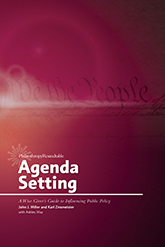Site Search
- resource provided by the Forum Network Knowledgebase.
Search Tip: Search with " " to find exact matches.
Stanford Social Innovation Review is a quarterly magazine produced by the Stanford Center on Philanthropy and Civil Society at Stanford University.
CNJG members are eligible for $10 off a subscription to Stanford Social Innovation Review (SSIR). The discounted rate is $39.95 for a one year print plus digital subscription for U.S. subscribers who subscribe online with credit card.
To obtain this discount, visit the Forum & CNJG members page on the SSIR website.
SSIR also offers a free enewsletter, announcing news and events of interest to nonprofits, foundations, and socially responsible businesses. Signing up is very fast and easy—just go to their homepage and enter your email address in the enewsletter box.
ASAE & The Center for Association Leadership's landmark study and publication 7 Measures of Success identified the ability to build effective alliances or partnerships that advance the mission as one of the hallmarks of a remarkable association. But getting a partnership right is an involved undertaking. That's what The Power of Partnership, itself the result of a strategic research collaboration of ASAE & The Center and the U.S. Chamber of Commerce, is all about. The book takes a no-nonsense look at the intricacies of establishing successful partnerships between nonprofit organizations, between nonprofits and for-profit companies, and between nonprofit organizations and governmental entities.
Approximately 45 million foreign-born individuals from all over the world reside in the United States, more than in any other country, comprising nearly 14 percent of the U.S. population.
A 2021 poll from the Cato Institute shows 72 percent of respondents consider immigration to be good for the nation. Yet, many people continue to have complicated and conflicting opinions on the issue, often based on a lack of understanding of how the immigration system operates and exacerbated by disinformation campaigns.
Research helps identify what inspires people to act, while cultural interventions and organizing affect perceptions and how we relate to one another. In this webinar, we will explore the strategies and tactics organizations are deploying to move hearts and minds in support of immigration.
COST: Free for members and nonmembers
As Jewish institutions across the U.S., from synagogues to Jewish Community Centers, tighten security measures as a response to rising antisemitism, the Tepper Foundation noticed that fears were particularly heightened among young families. In response, the grantmaking foundation announced on Monday that it will deploy $2.5 million in emergency grants through its Security Fund to underwrite the cost of security personnel in Jewish institutions where young children are in attendance.
“By speaking with our grantees, we discovered that many of them don’t have security on the premises when young children are present. This was creating a good deal of anxiety among parents,” Marian Stern, a consultant who serves as a portfolio manager at The Tepper Foundation, told eJewishPhilanthropy.

Donating money to modify public thinking and government policy has now taken its place next to service-centered giving as a constructive branch of philanthropy. Many donors now view public-policy reform as a necessary adjunct to their efforts to improve lives directly.
This is perhaps inevitable given the mushrooming presence of government in our lives. In 1930, just 12 percent of U.S. GDP was consumed by government; by 2012 that had tripled to 36 percent. Unless and until that expansion of the state reverses, it is unrealistic to expect the philanthropic sector to stop trying to have a say in public policies.
Sometimes it’s not enough to build a house of worship; one must create policies that make it possible for people to practice their faith freely within society. Sometimes it’s not enough to pay for a scholarship; one must change laws so that high-quality schools exist for scholarship recipients to take advantage of.
Yet public-policy philanthropy has special ways of mystifying and frustrating practitioners. It requires understanding of governmental practice, interpretation of human nature, and some philosophical perspective. Public-policy philanthropists may encounter opponents operating from different principles who view them as outright enemies. Moreover, public-policy struggles never seem to end: victories one year become defeats the next, followed by comebacks, then setbacks, and on and on.
This book was written to help donors navigate all of those obstacles. It draws on deep history and rich interviews with the very best practitioners of public-policy philanthropy in America today. Whatever your aspirations for U.S. society and governance, this guide will help you find the best ways to make a difference.
